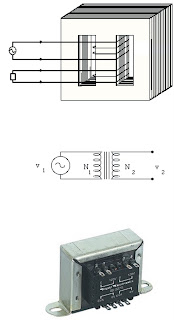TRANSFORMER

Transformer
What is a Transformer
A transformer is an electrical apparatus designed to convert alternating current from one voltage to another. It can be designed to "step up" or "step down" voltages and works on the magnetic induction principle. A transformer has no moving parts and is a completely static solid-state device, which ensures under normal conditions, a long and trouble-free life. It consists, in it's simplest form, of two or more coils of insulated wire wound on a laminated steel core. When an alternating voltage is introduced to one coil, called the primary, it creates a fluctuating magnetic field in the iron core. This fluctuating field then induces an alternating voltage in the other coil, called the secondary or output coil. The change of voltage (or voltage ratio) between the primary and secondary depends on the turns ratio of the two coils. In the schematic shown V2 = V1 x N2/N1.
Transformers are not limited to one output coil. They can provide a whole range of voltage sources from the one input coil by using separate windings on the secondary side. This makes transformers very useful for supplying complete systems with all of their voltage requirements from one source. The photo on the right shows a transformer with two input and two output windings. The input windings are on the top. Connecting the input windings in parallel allows a standard input voltage of 120v to be used to provide the two 6v outputs. If the input windings were connected in series the input voltage would have to be 240v before the same 6v outputs would be available. Similarly the two output windings can be connected in parallel to increase the current capabilities of the voltage supply or in series to double the voltage to 12v. This makes the "multi-tap" transformer a very useful and flexible device.

Comments
Post a Comment